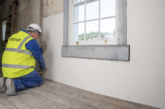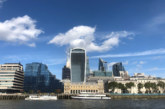 In just 13 years’ time, the Government wants to see a 78% reduction in emissions from public sector buildings. But with the clock already ticking to the 2035 deadline, what is the most effective way to achieve this? Wayne Oakes, Director at the sustainable engineering consultancy, Dice, offers a perspective.
In just 13 years’ time, the Government wants to see a 78% reduction in emissions from public sector buildings. But with the clock already ticking to the 2035 deadline, what is the most effective way to achieve this? Wayne Oakes, Director at the sustainable engineering consultancy, Dice, offers a perspective.
Imagination and creativity are two watchwords to champion when considering how to make government buildings more eco-friendly. Late last year, the Cabinet Office set out new guidance on how it will seek to reduce emissions from public sector buildings which include hospitals, job centres, council offices and prisons.
It has pledged an ambitious target — a 78% reduction by the year 2035 — which came hot on the heels of COP26, the world’s biggest ever summit on addressing climate change. Furthermore, the Government wants these public buildings to become net zero by 2050.
Get it right, and there are huge gains to be made. Making government buildings more sustainable is important as it is Britain’s biggest property estate. Emissions from public buildings contribute significantly to global warming every year. The benefits of reducing the carbon footprint from so many buildings across the UK is therefore clear to see, and can encourage private sector organisations to follow suit.
But it is one thing setting a target and another reaching it. So just how do the Government and public sector agencies get there?
Having worked with public sector agencies and private companies on sustainability projects for more than three years, we believe there are some fundamental points — or ingredients — to consider. These are:
Future focus: Government and public sector leaders should be in no rush to knock down buildings in favour of developing brand new ones in their place. Rather than demolishing and rebuilding these places, the most sustainable way to improve them is to retrofit them. There’s a saying which reads: ‘the greenest building is the one already standing’. So we need to find ways to improve and adapt our buildings rather than simply replacing them. This is because knocking down and rebuilding is a process which itself creates more embodied carbon and waste.
Funding: In terms of the public estate, it’s an ageing property portfolio that’s underfunded, which results in maintenance issues and poor performance from a sustainability perspective. Budget needs to be dedicated to this portfolio to help realise the target and ambitions set out with the emissions drive.
Fit for purpose: In addition to this, if the Government is to establish guidance which works to regulate itself, it needs to lead by example. It’s not only a question of sustainability but also comfort. Prisons and hospitals need to be fit for purpose and provide a social value element to better benefit the communities they stand in.
While a huge challenge to meet these emissions targets lie ahead, it is also an incredibly exciting time laden with opportunity to really push for a ‘greener’ future.
The Government has also published a Net Zero Estate Playbook, which will help inspire and guide public sector organisations on effective ways to reduce carbon emissions. This guide highlights encouraging consistent approaches to using solar panels, greener building materials, EV vehicle charge points and LED lighting.
As a multi-disciplinary engineering consultancy, we offer intelligent civil and structural engineering design, and embrace creativity and new technologies to support a changing world.
As well as being paperless, the Dice team aims to implement at least one element of sustainability into every piece of work it delivers. We heavily champion modern methods of construction (MMC) and modular housing, and we are currently working towards becoming a net zero business.
The new guidance for Government buildings aims to make national infrastructure ‘greener’ by giving Government departments, the public sector and government property professionals clear guidance on the design, implementation, and monitoring of net zero strategies and delivery programmes. The approaches can be applied to existing and new-build properties and aims to encourage the use of low carbon materials and provide an improved understanding of a building’s environmental impact over its entire lifespan.
The UK was the first major country to legislate for net zero. In hosting COP26, it is also seeking to set an example globally in reducing emissions. This ‘road map’ for Government buildings — if followed correctly — can help this country take a big step towards reaching these ambitious, but hugely important targets to benefit us all.
Header image ©Elnur/AdobeStock









